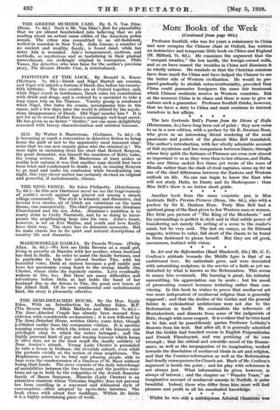* * * * In Art and the Reformation (Basil
Blackwell, 25s.) Mr. G. C.
Coulton's attitude towards the Middle Ages is that of an embittered love. Its cathedrals grew, and were decorated with astonishing sculpture, in the service of a faith as yet un- disturbed by what is known as the Reformation. This seems to annoy him overmuch. His learning is great, his industry unremitting, his appreciation can be acute ; but his mood of prosecuting counsel becomes irritating rather than con- vincing. In this book he wishes to prove that mediaeval art was more independent of mediaeval religion than is generally supposed ; and that the decline of the Gothic and the general failure in ecclesiastical architecture were not due to the Reformation in itself. He contradicts the referenCes of Montalembert, and dissents from some of the judgments of Male, though with more respect. It is evident that he tries hard to be fair, and he punctiliously quotes Professor Lethaby's dissents from his text. But after all, it is generally admitted that the Gothic had touched excess in English Perpendicular and French Flamboyant, and was perishing of its own triumph ; that the critical and scientific mood of the Renais- sance, as well as the neopaganism of its imagination, worked towards the dissolution of mediaeval ideals in art and religion, and that the Counter-reformation as well as the Reformation had deadly consequences for Church art. Much of Mr. Coulton's argument is beside the point ; and his play with references is not always just. What information he gives, however, is always of interest ; and the chapter on " Wander Years," an imaginative account of mediaeval masons in Norfolk, is quite beautiful. Indeed, those who differ front: him most will find pleasure and profit in all his marshalled knowledge. * * * *








































 Previous page
Previous page